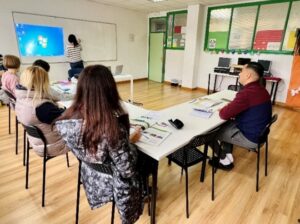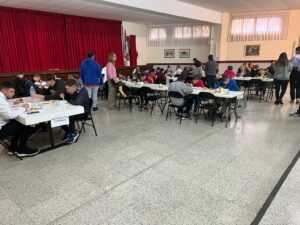The San Viator Center in Valladolid has always been described as a house that welcomes. Since the end of its life as a seminary, in 1994, the center has been available for groups for annual retreats, meetings, assemblies and provincial gatherings.

Refugees learning skills to help them in their new country.
However, Viatorians conceded that for many years, much of the building has been in disuse, with extensive facilities empty or just being used as warehouses. In the summer of 2017, an opportunity arose to use these areas in ways that would live out a message from Pope Francis:
“Dear men and women religious, empty convents do not serve the Church to transform it into hotels and earn money. The empty convents are not ours, they are for the flesh of Christ who are the refugees. The Lord calls us to live with more courage and generosity the welcome in the community, in the houses, in the empty convents… ” (He offered these words during a 2013 visit to a Jesuit-run refugee aid center in Rome.)
In response, Viatorians have worked to convert one wing of the San Viator Center into a welcoming center. For the last five years, they have worked with the environmental consulting firm, GEOCyL as well as the Spanish Catholic Migration Commission Association, or CCEM, to open their doors and welcome migrants. Since 2017, they have welcomed more than 1,700 refugees, or around 450 families, waiting for asylum papers in Spain.

Bikes parked below a mural painted by a migrant from Iran.
The main countries of origin are:
- America: Venezuela, Colombia, El Salvador, Honduras, Peru and Mexico.
- Africa: Morocco, Algeria, Senegal, Cameroon and Angola.
- Europe: Ukraine, Georgia and Russia.
- Asia: Syria and Iran.
In addition, Viatorians in Valladolid opened their doors last summer to another group: a group of children from a Ukrainian orphanage for children with disabilities, whose facilities were bombed and destroyed.
Starting in 2019, they had been renovating another floor of the building which had been empty or used as warehouses. The goal was to convert the space into a bunk bed shelter. This added room allowed Viatorians to welcome a group of 73 children, most of them with special needs, back in August.

Ukranian children enjoy a meal.
Some of the children with severe disabilities were referred to other facilities, however, currently they are serving 54 children between the ages of 10 and 17, and it is expected that 15 of them will soon be referred to other resources.
“Among all of us who work here, we want to continue building a San Viator Center that is a house of wide reception,” said Luis Martin Cabello, San Viator Center Administrator in a December newsletter, “so that with the activities that are carried out here we can be ‘more light’ for our recipients, for the neighborhood, the city and for the world in which we live.”



